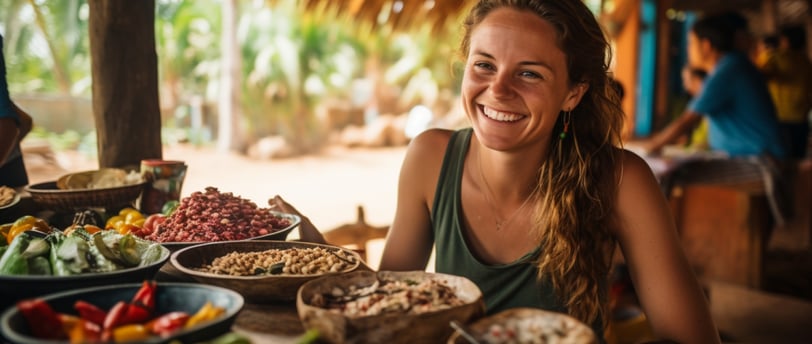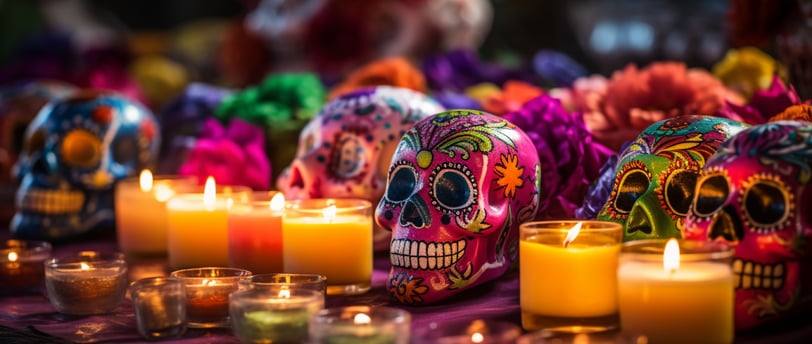Quick and Simple Ways to Immerse in Mexico's Rich Cultural Tapestry
In this article, we will explore some quick and simple ways to immerse yourselves in Mexico's rich cultural tapestry.

Mexico is a country rich in history, heritage, and culture. From its vibrant art and music scene to its mouthwatering cuisine and colorful festivals, Mexico offers a tapestry of experiences for travelers seeking a deeper understanding of this captivating country.
Understanding Mexico's Cultural Diversity
Mexico is a melting pot of cultures, with a diverse mix of indigenous, European, and African influences. Understanding this cultural diversity is essential to truly appreciate Mexico's rich tapestry.
When we delve into the indigenous influence on Mexican culture, we uncover a world of ancient civilizations that have left an indelible mark on the country. The Maya, Aztec, and Zapotec people, among others, have played a significant role in shaping Mexican culture. Their legacy can be seen in the magnificent ruins they left behind, such as the awe-inspiring Chichen Itza and the mystical Palenque. These archaeological sites not only showcase the architectural brilliance of these civilizations but also offer a glimpse into their complex belief systems and societal structures.
But it is not only in the remnants of their ancient cities that we find the indigenous influence. It permeates every aspect of Mexican society, from the vibrant traditional clothing adorned with intricate patterns and vibrant colors to the rhythmic beats of indigenous music and dance. These cultural expressions are a testament to the resilience and creativity of the indigenous communities, who have managed to preserve their traditions despite centuries of change.
If you truly want to immerse yourself in the indigenous cultures of Mexico, there is no better way than to visit their communities. In Oaxaca's Zapotec village of Teotitlán del Valle, for example, you can witness firsthand the weaving techniques passed down through generations. The locals will gladly share their knowledge and stories, allowing you to appreciate the intricate craftsmanship behind each textile. Similarly, in Chiapas' San Juan Chamula, you can witness ancient rituals that have been performed for centuries, gaining insight into the spiritual beliefs that have shaped the lives of the indigenous people.
Now, let's turn our attention to the Spanish impact on Mexican traditions. The arrival of the conquistadores during the Spanish colonization of Mexico brought about a fusion of cultures that continues to shape Mexican identity to this day. The Spanish introduced their language, traditions, and religion, which blended with the existing indigenous cultures, creating a unique cultural tapestry.
One of the most prominent examples of this fusion is the Day of the Dead, a celebration that combines indigenous beliefs with Catholicism. This vibrant and colorful holiday, observed throughout Mexico, honors the memory of departed loved ones. From the elaborate altars adorned with marigolds and sugar skulls to the traditional foods and lively processions, the Day of the Dead is a testament to the resilience of Mexican culture in the face of adversity.
When exploring Mexico's colonial cities, such as Guanajuato, San Cristobal de las Casas, or the historic center of Mexico City, you can witness the Spanish influence firsthand. The cobblestone streets, lined with colorful buildings, transport you back in time to the colonial era. The baroque architecture, with its intricate details and grand facades, is a visual reminder of the Spanish presence in Mexico. As you wander through the bustling markets and interact with the locals, you can't help but feel the echoes of the past, where Spanish and indigenous cultures intertwined.
Understanding Mexico's cultural diversity is an ongoing journey, one that requires exploration and engagement. By immersing ourselves in the indigenous communities and colonial cities, we gain a deeper appreciation for the contributions of each culture and the intricate tapestry they have woven together. Mexico's rich heritage is a testament to the resilience and creativity of its people, and by embracing its diversity, we can truly understand and celebrate the beauty of this remarkable country.
Engaging with Local Cuisine
Mexican cuisine is renowned worldwide for its bold flavors, vibrant colors, and diverse ingredients. Digging into Mexico's culinary traditions is a delicious way to understand its culture.
When it comes to Mexican cuisine, there is so much more than meets the eye. It is not just about the taste; it is about the history, the traditions, and the stories behind each dish. Mexican cuisine is a result of blending indigenous ingredients and techniques with European flavors brought by the Spanish. From street tacos to mole poblano, each dish has a story to tell.
Exploring local markets, like Mercado San Juan in Mexico City or Mercado Benito Juarez in Oaxaca, provides a captivating feast for the senses. As you walk through the bustling aisles, you can smell the fragrant spices, taste the exotic fruits, and interact with local vendors who are more than willing to share their knowledge about the traditional ingredients and cooking methods. It is an opportunity to immerse yourself in the vibrant culture and culinary heritage of Mexico.
The Art of Mexican Cooking
Delving deeper into the art of Mexican cooking, you will discover that it is not just about following a recipe. It is about understanding the techniques, the passion, and the love that goes into every dish. Mexican cuisine is a true reflection of the country's history, with influences from the ancient Mayans and Aztecs to the Spanish conquistadors.
Take, for example, the famous mole poblano. This rich and complex sauce is made with a combination of chili peppers, chocolate, spices, and other ingredients. Legend has it that it was created by nuns in the 17th century as a special dish for a visiting archbishop. The recipe has been passed down through generations, with each family adding their own twist to it. Trying a plate of mole poblano is like taking a bite out of history.
Traditional Drinks and Their Significance
Beyond the delicious food, Mexico also boasts a variety of traditional drinks that play an important role in its cultural tapestry. These beverages have been enjoyed for centuries and are deeply rooted in Mexican traditions.
One such drink is cacao, which has been consumed by the indigenous people of Mexico for thousands of years. The ancient Mayans believed that cacao was a sacred gift from the gods and used it to make a variety of beverages. Today, you can still find traditional cacao drinks being made in some parts of Mexico, offering a taste of history and a glimpse into the ancient Mayan civilization.
Of course, no discussion of Mexican drinks would be complete without mentioning tequila and mezcal. These iconic spirits have become synonymous with Mexico and are enjoyed by people all over the world. Tequila, made from the blue agave plant, is produced primarily in the state of Jalisco. Visiting tequila distilleries in Jalisco allows you to witness the production process firsthand and learn about the regional variations and significance of this beloved Mexican drink.
Mezcal, on the other hand, is made from different varieties of agave and is primarily produced in the state of Oaxaca. It has a distinct smoky flavor and is often enjoyed neat or in cocktails. Exploring mezcal distilleries in Oaxaca gives you the opportunity to learn about the traditional methods of production and appreciate the craftsmanship that goes into making this unique spirit.
Whether you are sipping on a traditional cacao drink, enjoying a glass of tequila, or savoring the flavors of a mole poblano, engaging with Mexican cuisine is not just about the food and drinks. It is about immersing yourself in a rich tapestry of history, culture, and traditions that have been passed down through generations. So, next time you find yourself in Mexico, be sure to explore the local markets, visit distilleries, and indulge in the culinary delights that make this country so special.

Participating in Mexican Festivals and Celebrations
Mexico is synonymous with vibrant festivals and celebrations, each with its unique meaning and significance. Engaging in these festivities allows you to experience the heart and soul of Mexican culture.
The Importance of Religious Festivals
Religion plays a central role in Mexican society, and religious festivals are an integral part of the cultural fabric. From Semana Santa (Holy Week) processions in Taxco to the feast of Our Lady of Guadalupe in Mexico City, these religious events showcase Mexico's devotion, spirituality, and artistry. Attend these festivals to witness traditional dances, intricate costumes, and breathtaking rituals that create a sense of unity and community.
Seasonal Celebrations and Their Meanings
Seasonal celebrations, such as Dia de los Muertos (Day of the Dead) and the Guelaguetza festival, provide a glimpse into Mexico's pre-Hispanic traditions. Dia de los Muertos, celebrated throughout Mexico but with particular significance in Oaxaca, is a colorful and festive tribute to deceased loved ones. The Guelaguetza festival, held in Oaxaca, showcases the state's diverse indigenous cultures through elaborate costumes, music, dance, and traditional performances. Participate in these celebrations to witness the beauty and depth of Mexico's cultural heritage.
Exploring Mexican Art and Music
Art and music are deeply woven into the fabric of Mexican society, expressing its history, values, and emotions. Exploring Mexico's artistic scene is a great way to immerse yourself in its cultural tapestry.
The Evolution of Mexican Art
Mexico has a rich artistic tradition spanning from ancient civilizations to contemporary times. From the ancient murals at Teotihuacan to the vibrant works of Frida Kahlo and Diego Rivera, Mexican art reflects its diverse roots and struggles. Visit renowned museums like the Palacio de Bellas Artes in Mexico City or the Frida Kahlo Museum in Coyoacan to witness these artistic legacies firsthand.
The Role of Music in Mexican Society
Music forms an integral part of Mexican culture, with genres like mariachi, ranchera, and banda filling the airwaves and hearts of the people. From lively street musicians in Guadalajara to traditional mariachi performances in Plaza Garibaldi, Mexico City, the country resonates with melodious tunes. Attend live performances, learn traditional dances, or even take a music workshop to truly appreciate the joy and passion that Mexican music embodies.
Learning the Spanish Language and Regional Dialects
Learning the Spanish language and understanding regional dialects can deepen your cultural immersion and forge connections with the locals.
The Importance of Spanish in Mexican Culture
Spanish is the official language of Mexico and plays a crucial role in daily life, social interactions, and cultural expressions. Embracing the Spanish language allows you to communicate more effectively, appreciate local literature and poetry, and engage with locals on a deeper level. Consider taking a language course, practicing conversational skills with native speakers, or using language learning apps and resources to enhance your language abilities.
Understanding Regional Dialects and Their Origins
Mexico's vast geographic expanse has given rise to a wide variety of regional dialects, each with its unique characteristics and influences. From the sonorous accents in Yucatan to the distinctive slang of Mexico City, learning about these dialects provides insights into the local culture and fosters meaningful connections with people. Engage in conversations with locals, learn common phrases, and embrace the linguistic diversity that enriches Mexico's cultural tapestry.
Immersing yourself in Mexico's rich cultural tapestry is an experience that will leave a lasting impression. From exploring indigenous communities and savoring mouthwatering dishes to dancing to the rhythms of Mexican music and engaging with locals, every step will deepen your understanding of this vibrant country. So embark on this cultural journey and let Mexico's tapestry unfold before you.